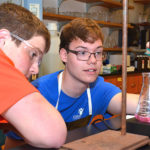Limb-lengthening surgery: A look at the pros and cons

Limb length discrepancies, a leg or arm that’s shorter than the other, can occur for a number of reasons. A child may be born with a condition that causes one limb to grow more slowly than the other. An arm or leg may stop growing after a complex fracture or a fracture that heals incorrectly. Or surgery to remove a bone cyst may stunt the growth in that limb. In such cases, limb-lengthening surgery may be an option.
Dr. James Kasser, Dr. Carley Vuillermin, and Dr. Collin May have lengthened many patients’ legs and arms over the years. As orthopedic surgeons in the Limb Lengthening and Reconstruction Program at Boston Children’s Hospital, they’ve been at the forefront of adopting new technologies that have improved patient experience and outcomes. But while many of their patients benefit from limb lengthening, these doctors make it clear that the procedure is not for everyone.
Before a patient or family commits to limb lengthening, they need to understand what the procedure entails and its inherent risks. Here, Drs. Kasser and Vuillermin describe what limb lengthening is, how it works, and what patients need to know before deciding if the choice is right for them.
How does limb lengthening work?
Dr. Vuillermin: Limb lengthening stimulates bone in a patient’s leg or arm to grow longer. We do this by surgically cutting the bone and attaching a device that slowly moves the two ends of the bone apart. As space opens up between these two ends, new bone grows to fill in the gap. Often, patients undergo several cycles of lengthening over the course of several years, depending on their age, stage of growth, and amount of lengthening needed.
… the patient and their family have to fully understand the risks and have a realistic idea of what outcomes they can expect if they choose this procedure. It’s a team commitment.”
Dr. Carley Vuillermin
Most often, limb lengthening is used to correct a leg length discrepancy. Our goal in leg lengthening is to make the body level in order to prevent back, hip, and knee problems that can result from walking around on legs of two different lengths. Most arm-length differences don’t have this sort of impact. It’s only when a shorter arm interferes with activities of daily life that lengthening is considered.
How do you create the space where new bone can grow?
Dr. Kasser: There are a couple of different devices that can create a gap in the bone. The first is a frame that the patient wears on the outside of their leg or arm for several months. Following the initial surgery, a family member or the patient expands the frame — and the bone — a tiny amount at regular intervals to stimulate bone growth.
Now there’s another option that many patients prefer: an expandable rod. After we cut the bone, the rod is inserted into it. The rod is lengthened with a magnetic controller on the outside of the limb. Compared to the frames, the internal device causes less damage to the skin and muscles around the bone and reduces the risk of infection.
What happens to the skin, muscles, and nerves around the bone during lengthening?
Dr. Vuillermin: As we lengthen a bone, we are also slowly stretching the soft tissues around the bone. I compare it to daily stretching: You may start with tight hamstrings, but with gentle stretching, you’ll eventually be able touch your toes without pulling the muscle.
We monitor patients very closely throughout this process. If a nerve is getting stretched too far or a muscle is getting too tight, we will slow down, or may even stop, the lengthening process.
Are there risks associated with limb lengthening?
Dr. Kasser: There are some serious risks. Limb lengthening puts patients at risk of nerve damage, muscle damage, joint contracture, dislocations, and arthritis. We make sure our patients know this while they are weighing their options. By monitoring the lengthening process and modulating it as needed, we can prevent, or at least markedly decrease, the complications that are inherent in lengthening operations.
Our philosophy is, how can we help our patients have the best outcome? A big part of that is understanding what’s going to work best for each individual patient.”
Dr. James Kasser
Dr. Vuillermin: Everyone undergoing limb lengthening will have complications. It’s a matter of what those complications will be and how quickly we can detect and reverse them. With planning before surgery and a very careful approach during surgery, we can minimize the risk and complications.
I’ve adopted Dr. Kasser’s philosophy of limb lengthening, which is that the patient and their family have to fully understand the risks and have a realistic idea of what outcomes they can expect if they choose this procedure. It’s a team commitment.
What are the alternatives to limb lengthening?
Dr. Kasser: Another option is prosthetic management. In some cases, a prosthesis can be adapted to a malformed limb to improve the patient’s mobility. At times, an amputation of the shorter limb is required. While this may seem extreme, for many patients amputation is the best option. Many of our patients who had an amputation are now out running around, participating in competitive athletics or just doing the things kids do, with prosthetic limbs.
How do you help patients and families decide?
Dr. Kasser: Our philosophy is, how can we help our patients have the best outcome? A big part of that is understanding what’s going to work best for each individual patient. Some patients are willing to live with the multiple surgeries and risks that come with limb lengthening. For others, amputation means fewer operations and greater mobility with the use of a prosthesis.
Our role is to bring our patients and their families through a thoughtful process so they can make the choice that’s right for them.
Learn more about the Limb Lengthening and Reconstruction Program.
Related Posts :
-

One family, two very different clubfoot experiences
Theresah Boateng and her daughter Eno Agyapomaa Agyemang both have strong wills and outgoing personalities. Both were born with a ...
-

Fingers, shoulders, and everything in between: Three upper extremity surgeons and their relentless quest for solutions
It’s 6 a.m. and the surgeons in the Hand and Orthopedic Upper Extremity Program at Boston Children’s Hospital ...
-

George the unstoppable conquers leg-length discrepancy
George Davies, a senior at Bancroft School in Worcester, Massachusetts, faces every challenge, every obstacle and every situation with a ...
-

Foot deformity and amputation: Maria's tough choice
Whenever she could, Maria Dupuis found a way to walk. She walked when she had to wear a cast from ...





